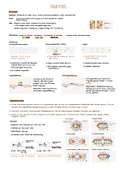Strategy
Professor: Christophe Crombez
Inhoud
Introduction............................................................................................................................................3
Nonmarket strategies/political strategies..........................................................................................3
Course objectives...................................................................................................................................3
1) Condorcet Paradox.............................................................................................................................5
2) Agenda setting....................................................................................................................................5
3) Strategic voting...................................................................................................................................6
4) Arrow..................................................................................................................................................7
1) Spatial Theorem...............................................................................................................................11
2) Median Voter Theorem....................................................................................................................12
3) Plurality systems...............................................................................................................................13
Winner takes it all versus proportional system................................................................................14
Difference between parliamentary system and presidential system....................................................15
1) EU institutions..................................................................................................................................16
1.1 The Council.................................................................................................................................16
1.2 The Parliament...........................................................................................................................17
1.3 The commission..........................................................................................................................20
1.3 Comparison with US institutions.................................................................................................21
3) Legislative procedures......................................................................................................................22
1) Chocolate legislation........................................................................................................................23
2) The market for chocolate: major chocolate producers....................................................................24
3) Principal affected interests...............................................................................................................25
4) Preferences of EU institutions..........................................................................................................26
5) Legislative process............................................................................................................................26
6) Explanation of the Belgian vote........................................................................................................27
7) Analysis of the legislative outcome..................................................................................................27
1) EU Trade Policy.................................................................................................................................29
2) The EU and the WTO........................................................................................................................29
3) Transatlantic Trade Relations...........................................................................................................30
1) Introduction: Daylight Savings Time.................................................................................................31
2) 4 I’s: Issues........................................................................................................................................32
1
,3) 4 I’s: Interests...................................................................................................................................34
4) 4 I’s: Institutions...............................................................................................................................39
5) 4 I’s: Information..............................................................................................................................39
1) Introduction......................................................................................................................................39
2) The Nature of Political Competition.................................................................................................40
1) Boeing in a Pickle..............................................................................................................................41
2) Calgene, Inc. and Infrastructure marketing......................................................................................45
3) Manufacturing Politics: RBOCs.........................................................................................................46
1) Natural monopolies..........................................................................................................................49
2) Solutions...........................................................................................................................................50
3) Price-Cap Regulation........................................................................................................................52
4) Cross-subsidization...........................................................................................................................52
5) Deregulation in Telecom..................................................................................................................53
1) Externalities......................................................................................................................................53
2) Public goods.....................................................................................................................................54
3) Asymmetric information...................................................................................................................55
1) Approach..........................................................................................................................................56
2) Objectives.........................................................................................................................................57
3) Coase theorem.................................................................................................................................59
4) Transaction costs..............................................................................................................................60
5) Regulation........................................................................................................................................61
1) Approach..........................................................................................................................................61
2) Objectives.........................................................................................................................................62
3) Regulation........................................................................................................................................62
Summary
Guest lecture: Adalbert Jahnz
2
,Introduction
Nonmarket strategies/political strategies
If you found a company or open a store, you need a good business plan. You need to think about the
product, money and marketing. This is your market strategy. But a bunch of other issues will pop up:
a building permit, environmental concerns, diploma, fiscal policies,.. You need to think about these
too => you need a nonmarket/political strategy.
The same is true for large, established companies. Also for companies who interact in a market
environment (voluntary transactions, private agreements,… ). Effective market management is not
enough though.
Firms are also active in a nonmarket environment: social framework, legal, political. They interact
with government bodies, interest groups, activists.
Interactions in the nonmarket environment are very important, especially in Europe. And
increasingly: environmental concerns, product safety, media, (de)regulation, international trade.
Main actors in politics:
- Politicians: they want to reach the top level of the country: prime minister. They want to be
powerful. Maybe some politicians want the total amount of welfare in the society to
maximize (public wealth and wellbeing).
- Interest groups: companies, environmental groups: they give them status and money: not in
Belgium
- Voters: what does them affect?
The political environment is very important
In politics: we obtain the rule of law: we comply to the rules: it’s not voluntary.
Market strategies direct market competition and determine revenues and profits. Competing
nonmarket strategies determine legislation, regulation, public pressure. They compete in legislatures,
courts, regulatory agencies, public opinion
Extra:
Grass roots protest= a protest that grew spontaneously (for example in the Leuven high school,
because the school got a different name).
In Belgium politics represent half of the economy. In other countries that’s a lot lower.
Course objectives
Provide a framework
Think about nonmarket issues and analyze them
Formulate strategies to detect (life cycle) and deal with such issues
Political analysis
Framework for the analysis of political decision making
Political theories of regulation
Importance for industry
3
, Political strategy
Framework for the formulation of political strategies
Case studies
Political strategy and economic efficiency
- Regulation, antitrust, product safety, environment, case studies
We try to have an impact of what happens in the political environment: you have to compete against
other interest groups. The first thing that will be affected are the rules, the legislation, the subsidies
and they have an impact on the profits of the company. Later on we will see the strategies
companies could use.
The most issues have a lifecycle. BV: Climate change exists already a long time, but now it’s getting a
lot of attention. This doesn’t imply that it will be in the media tomorrow.
4











